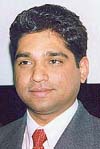
Monday,
May 5, 2003
|
 |
Guest
Speak |
 |
Smart offices will
maximise business productivity
Lakshmi Narayan Rao

Lakshmi Narayan Rao,
Assistant Director, Marketing OSS Value,
Canon India Private Ltd. |
There’s
nothing jovial in Joy’s life. His life in the fast lane of the
advertising world hits too many speed breakers everyday. It all starts
at home - where even a quick breakfast is interspersed with business
calls! He loves driving but driving isn’t a pleasure for him as there
invariably a major traffic jam at each of the major intersections on the
15 kilometers drive he makes to his supposedly posh office in what he is
told is a technology park.
Once there, he struggles
to find a proper parking space and his woes continue as he enters his
hi-tech office, which is spread across two floors. The office may be an
architectural marvel, but for poor Joy, the spacious office space isn’t
a boon, it’s more of a nightmare as it designed in a manner that one
constantly has to move from department to department to complete single
tasks. The other day he had to send the final proof of an advertisement
to one of his clients and this routine task kept him busy till the wee
hours of the morning. Only he wasn’t doing anything creative. Most of
the time he was just running from his desktop to the printer and then to
the photocopier.
Joy has no happiness in
his life except for his name!
Taking a cue from the
above instance and the other problems that people face at work, as a
better understanding of that will help us identify the desired
characteristics of an ideal Smart Office environment.
Today the four most
immediate problems faced by users of office equipment are:
1) Too many machines:
Technology is supposed to simplify our lives but this does not happen
with multiple printers, scanners, photocopiers spread across the office
on various floors. This multiplicity of equipment and duplicity of
functionality also results in a significantly high level of investment.
2) Communication:
Offices these days, typically, are not conducive to communication as
people usually work in cubicles that naturally isolate them from each
other. Communication and access to shared resources is an extremely
important criteria in today’s business environment, especially for
those businesses where the main competitive advantages of a company are
its employees and the synergies created between them.
3) Lighting condition:
Direct light from windows or lamps can interfere with vision.
Reflections on a computer/video display can interfere with the ability
to easily see characters on the screen and impact vision.
4) Fatigue:
Described as a vague tiredness or feeling of low energy, lack of
enthusiasm, or weakness, fatigue is caused by poor posture, chair
support, not properly fitting on your workstation or arranging the
materials and equipment on one’s desk. Fatigue can be demoralising and
make one acquire the attitude of ‘who cares if I get my work done.’
Fatigue is a quite way of making one care less and less about one’s
job and may even make one feel frustrated.
A smart office takes care
of all these problems with technology as the key enabler to simplify
lives. Some of the basic characteristics of today’s smart office are:
1. The need to staying
connected without being in the office: No longer is a forgotten file a
career threatening problem, as employees are now able to access,
download, print and share documents from wherever they are.
2. Optimum utilisation of
office space: Given that space is becoming a rare commodity and is more
often then not at a premium. Sleek and modern multifunctional devices
that consolidate and perform multiple functionalities are set to
increasingly replace large single functionality offices devices.
3. Technology plays the
dual role of a lifestyle enabler and knowledge conduit: Individual will
now have access to digital imaging tools that are relevant to both home
and office environments. With the advent of photo direct printers,
mobile printers, and networked AIO digital imaging equipment, the
computer will become obsolete and professionals will be able to access
their documents from stand alone devices without necessarily using a
computer.
In today’s uncertain
business world one thing is certain. Technology is set to change office
layouts and the way people work. Computers will get smaller; monitors
will get thinner and cellphones and handsets will further reduce
dependence on personal secretaries. As we go forward, offices will get
more and more connected and there will be a need for integrating
multifarious communication forms into one common conduit.
Multifunctional devices will transform themselves into these
communication conduits integrating printing, scanning, copying and fax
functionalities but also e-mail, i-fax and virtual mailbox facilities.
In today’s smart
offices, technology will provide individuals with better desktop
control, easy hardware upgradeability and integrated document
communication solutions. As technology continues to evolve in an endless cycle that will only accelerate and intensify, it is imperative
that management thinking mirrors this change so that organisations
effectively leverage off these technology development to maximise
employee and business productivity.
endless cycle that will only accelerate and intensify, it is imperative
that management thinking mirrors this change so that organisations
effectively leverage off these technology development to maximise
employee and business productivity.
In the future, as manual
interaction between workgroups and customers decline, intelligent IT
networks and communication hubs will become the information conduits for
businesses and emerge as the critical link connecting organisations.
|

